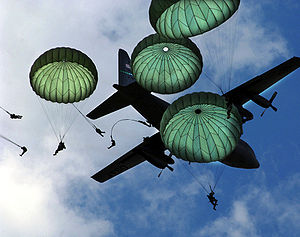
A parachute is a device used to slow the motion of an object through an atmosphere by creating drag or, in a ram-air parachute, aerodynamic lift. A major application is to support people, for recreation or as a safety device for aviators, who can exit from an aircraft at height and descend safely to earth.

Paragliding is the recreational and competitive adventure sport of flying paragliders: lightweight, free-flying, foot-launched glider aircraft with no rigid primary structure. The pilot sits in a harness or in a cocoon-like 'pod' suspended below a fabric wing. Wing shape is maintained by the suspension lines, the pressure of air entering vents in the front of the wing, and the aerodynamic forces of the air flowing over the outside.

The Rogallo wing is a flexible type of wing. In 1948, Francis Rogallo, a NASA engineer, and his wife Gertrude Rogallo, invented a self-inflating flexible wing they called the Parawing, also known after them as the "Rogallo Wing" and flexible wing. NASA considered Rogallo's flexible wing as an alternative recovery system for the Mercury and Gemini space capsules, and for possible use in other spacecraft landings, but the idea was dropped from Gemini in 1964 in favor of conventional parachutes.

The airspeed indicator (ASI) or airspeed gauge is a flight instrument indicating the airspeed of an aircraft in kilometres per hour (km/h), knots, miles per hour (MPH) and/or metres per second (m/s). The recommendation by ICAO is to use km/h, however knots (kt) is currently the most used unit. The ASI measures the pressure differential between static pressure from the static port, and total pressure from the pitot tube. This difference in pressure is registered with the ASI pointer on the face of the instrument.

A sea anchor is a device that is streamed from a boat in heavy weather. Its purpose is to stabilize the vessel and to limit progress through the water. Rather than tethering the boat to the seabed with a conventional anchor, a sea anchor provides hydrodynamic drag, thereby acting as a brake. Normally attached to a vessel's bows, a sea anchor can prevent the vessel from turning broadside to the waves and being overwhelmed by them.

The Helio Courier is a cantilever high-wing light STOL utility aircraft designed in 1949.

A drogue is a device trailed behind a boat on a long line attached to the stern. A drogue is used to slow the boat down in a storm and to prevent the hull from becoming side-on to the waves. A boat that has deployed a drogue should not overspeed down the slope of a wave and crash into the next one, nor will the vessel broach. By slowing the vessel, the drogue makes the vessel easier to control in heavy weather and will help to prevent pitchpoling.

A malfunction is a partial or total failure of a parachuting device to operate as intended. Malfunctions may require a skydiver to cut away their main parachute and deploy the reserve parachute.

A static line is a fixed cord attached to a large, stable object. It is used to open parachutes automatically for paratroopers and novice parachutists.
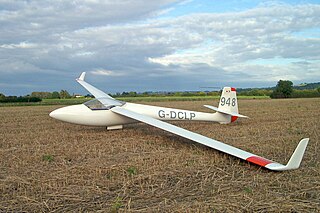
The Glasflügel 201 Standard Libelle is an early composite Standard Class single-seat sailplane produced by Glasflügel from 1967.
"Blood on the Risers" is an American paratrooper song from World War II.

A pilot chute is a small auxiliary parachute used to deploy the main or reserve parachute. The pilot chute is connected by a bridle to the deployment bag containing the parachute. Pilot chutes are a critical component of all modern skydiving and BASE jumping gear. Pilot chutes are also used as a component of spacecraft such as NASA's Orion.
A parachute rigger is a person who is trained or licensed to pack, maintain or repair parachutes. A rigger is required to understand fabrics, hardware, webbing, regulations, sewing, packing, and other aspects related to the building, packing, repair, and maintenance of parachutes.
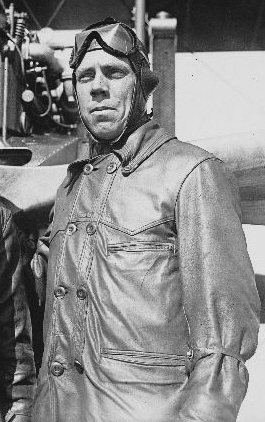
James Floyd Smith was an inventor, aviation pioneer, and parachute manufacturer. With borrowed money, he built, then taught himself to fly his own airplane.
RAPS or Ram Air Progression System is a parachuting training system designed to take a student from beginner to the FAI A License using square ram air canopies.
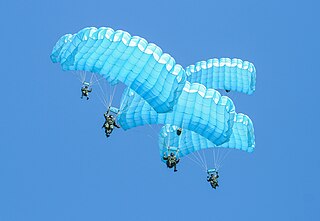
Parachuting and skydiving is a method of transiting from a high point in an atmosphere to the ground or ocean surface with the aid of gravity, involving the control of speed during the descent using a parachute or parachutes.

The Non-Maneuverable Canopy (T-11) Personnel Parachute System is the newest personnel parachute system to be adopted by the United States armed forces and the Canadian Army. The T-11 replaces the T-10, introduced in 1955. The T-11 includes a completely redesigned main and reserve parachute and an integrated harness assembly that is suitable for a wider range of soldier weights than the previous system.
CharlesBroadwick was an American pioneering parachutist and inventor. An executive director of the U.S. Parachute Association, Ed Scott, said "just about all modern parachute systems" use ideas Broadwick developed: "an integrated, form-fitting harness and container system nestled on the back." Broadwick developed the static line, a line from a parachute to an aircraft that pulls the parachute from its pouch. Static lines are still used by paratroopers and novice skydivers. U.S. Army Warrant Officer Jeremiah Jones commented, "[Broadwick] is like the grandfather of paratroopers." Broadwick demonstrated parachute jumps at fairs and taught and equipped famous female parachutist Tiny Broadwick.
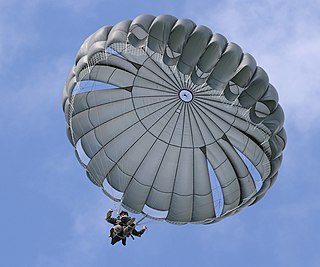
The MC-6 Parachute is a Maneuverable Canopy(MC) static line-deployed personnel parachute of the United States Armed Forces. Developed by United States Army Special Forces, the parachute has been used by American Special Operations Forces (SOF) beginning in 2006 and Australian SOF starting in 2011.
A main assisted reserve deployment (MARD) system is a skydiving safety device for parachute systems. While there are many variations, the operation and intended outcome for each is the same: open the reserve parachute container and extract the reserve parachute's deployment bag using the jettisoned main canopy. A MARD builds upon how a reserve static line (RSL) safety device works and in most circumstances, MARDs incorporate an RSL.
